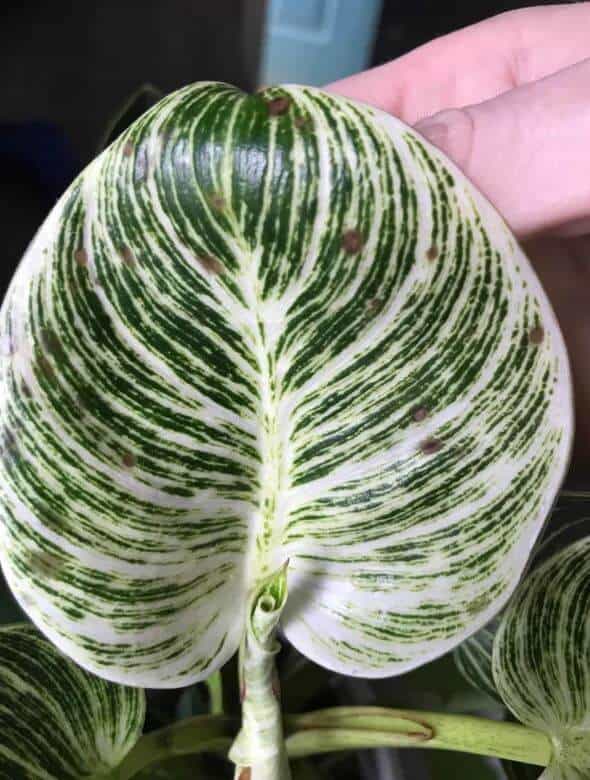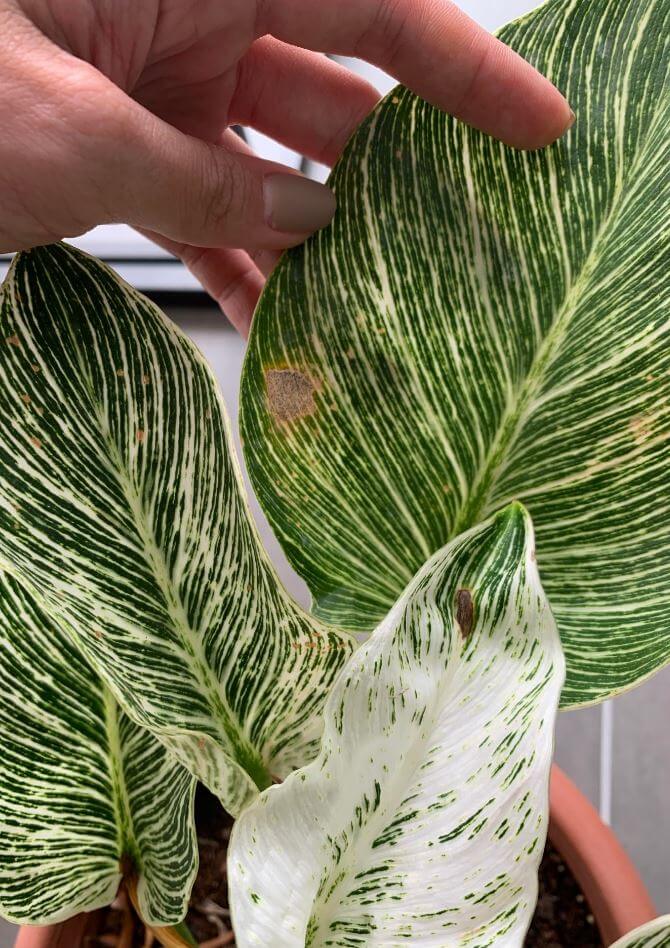Last Updated on September 9, 2023 by a Friendly Gardener
Philodendron Birkin plants are known for lush green leaves with striking white lines that decorate them. When you acquired your plant, it was most likely that glorious foliage that caught your eye and won your heart. After a while, however, there are spots on the philodendron Birkin plant. Is your plant ill, does it have pests, is it dying? And more importantly, what should you do?
The philodendron Birkin belongs to the Araceae family. Philodendron plants find their native habitats in the tropical rainforests situated in South and Central America. The Birkin is a hybrid, so it is not found in the wild. This compact plant was cultivated to develop thick, bright, green-hued stems, and oval pointed leaves with their stunning pinstripe variegation.
Why Are There Brown Spots on Birkin Leaves?

While philodendron varieties are generally hearty plants, brown spots do occasionally appear on the foliage. Brown spots are an alarm signal that something is upsetting your plant. It’s important to recognize the cause so you can nurture your plant back to health.
There are several common causes for brown spots appearing on a Philodendron Birkin with fungus or pest bites being the most common. Brown spot causes include:
- Fungal Infections
- Overwatering
- Pest Infestations
- Shock from transplanting
- Sunburn
- Underwatering
- Cold Injuries
Fungal Infections
Fungal infections can be easily overlooked, but fungal diseases and infections are, more often than not, the cause of philodendron Birkin brown spots on leaves. Generally, fungal infections are due to overwatering or if the fungus is present in the soil, the condition can worsen due to overwatering.
To treat a fungal infection, begin by pruning any foliage that has spots so that they do not spread to healthy leaves. Adjust your watering schedule and check your plant often for signs of a recurring infection. You can treat your plant with a fungicide. Neem oil is an organic fungicide that will not harm the plant when applied.
Overwatering

Overwatering any plant is bound to cause damage and can be fatal. Check the soil bed of your plant. If the soil is soggy or does not appear to dry at all, you are probably overwatering the Philodendron Birkin and depleting the oxygen supply in the soil. These plants will begin to wilt, and their color will fade and begin to turn yellow. Gradually brown spots will appear, and you may notice the development of mold and algae along the stem. The mold will eventually overtake the plant and may kill it.
To stop the damage from overwatering, stop watering the plant. Depending on how damaged the plant is, you can either attempt to allow the soil bed to dry out or for a more immediate solution repot your Philodendron.
Remove the plant from the soggy soil and trim off any damaged roots. Sick roots will appear mushy and brown and may emit an odor. Repot your plant in a fresh growth medium and wait approximately a week before resuming watering. When you resume normal care, water your plant once weekly unless the climate is very arid.
Pest Infestations
Most plant parents will not identify pests with brown spots, but if your plant does not have a fungal infection and is not overwatered, you may want to consider this possibility. Most houseplants are susceptible to pests.
Spider mites can be a significant problem and they may not be immediately visible. Look at the undersides of the leaves and the stems for signs of small webbing. Spider mites are sap suckers and will feed on the plant’s sap, stealing vital nutrients. As a result, brown spots may appear. Thrips are another type of pest that can do considerable damage to your philodendron.
If your plant has been infested by pests, remove it if it is near other houseplants. Wash the plant with jet sprays of water and insecticidal soap. Remove severely damaged foliage. Watch your plant for signs of re-infestation.
Shock Due to Transplanting or Repotting

Believe it or not, repotting your plant can be dangerous. Philodendron Birkin’s brown spots on leaves can indicate transplant shock. To prevent shock, hydrate your plant well for at least 24 hours before you plan on repotting it or transplanting it. If you repot, make sure the new container has an adequate number of drainage holes. You can also opt to thoroughly water the plant and roots immediately after repotting.
Sunburn
Houseplants are like humans; they are subject to sunburn when overly exposed to direct sunlight. The Philodendron Birkin needs a generous amount of light, even as much as twelve hours a day, but the light needs to be indirect. Exposing this philodendron cultivar to direct sunlight can scorch the foliage. Leaves will develop brown spots as they dry up.
To prevent scorching, place your plant in a window with a sheer curtain as a filter or near a window with bright light.
Underwatering
Underwatering is perhaps the easiest cause of brown spots to identify. The soil bed will be dried out and your plant may be wilting.
To revive your plant, establish a watering schedule. Temporarily move your plant to a spot with more shade to reduce evaporation until it revives. Remove foliage that is damaged.
Cold Injuries

If brown spots appear on the foliage between the veins, your philodendron may be suffering from a cold injury. The Philodendron Birkin should be kept in locations where temperatures never fall below 55°F. These plants should not be placed near air conditioning units or vents. Cold can negatively influence photosynthesis which is necessary for nourishment. When this happens, browning may appear.
Other Problems
Brown patches rather than spots may be indicative of infection. If leaves are showing patches, remove the affected leaves to prevent infection spread. Spray the plant with Neem oil or another fungicide and reduce your watering schedule a bit.
Brown or yellow edges can be a sign of salt buildup in the soil bed due to overfertilization. Make sure the soil is well-draining and flush your plant to remove buildup.
Yellow leaves may be the result of aging foliage, a lack of nutrients, or even underwatering if roots are incapable of sending adequate nutrients and water throughout the plant.
Philodendron Birkin yellow spots are often a symptom that a plant is suffering from bacterial leaf spots. This infection appears with favorable environmental conditions such as poor air circulation, the overcrowding of plants, or high humidity. Water droplets on foliage can also contribute to the reproduction of the infection. If your water schedule is irregular, the Birkin may be stressed and more susceptible to infections. Remove infected leaves and spray your Birkin with a copper-based product for bacterial infections. Make sure your plant is located in a well-aerated spot.
The Bottom Line

Brown spots are relatively common on Birkin leaves. If your plant appears healthy and continues to grow, don’t fret. If you can identify the cause, proceed with treating your plant to ensure continued plant health.


